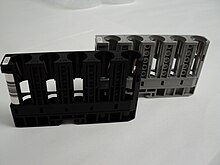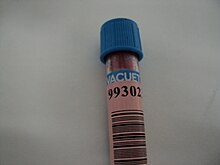
Back عداد الخلايا الإلكتروني Arabic Analizador automático Spanish تحلیلگر خودکار Persian Automate d'analyses médicales French Analizzatore automatico Italian Analizor automat Romanian Analysautomat Swedish
An automated analyser is a medical laboratory instrument designed to measure various substances and other characteristics in a number of biological samples quickly, with minimal human assistance. These measured properties of blood and other fluids may be useful in the diagnosis of disease.




Photometry is the most common method for testing the amount of a specific analyte in a sample. In this technique, the sample undergoes a reaction to produce a color change. Then, a photometer measures the absorbance of the sample to indirectly measure the concentration of analyte present in the sample. The use of an ion-selective electrode (ISE) is another common analytical method that specifically measures ion concentrations. This typically measures the concentrations of sodium, calcium or potassium present in the sample.[1]
There are various methods of introducing samples into the analyser. Test tubes of samples are often loaded into racks. These racks can be inserted directly into some analysers or, in larger labs, moved along an automated track. More manual methods include inserting tubes directly into circular carousels that rotate to make the sample available. Some analysers require samples to be transferred to sample cups. However, the need to protect the health and safety of laboratory staff has prompted many manufacturers to develop analysers that feature closed tube sampling, preventing workers from direct exposure to samples.[2][3] Samples can be processed singly, in batches, or continuously.
The automation of laboratory testing does not remove the need for human expertise (results must still be evaluated by medical technologists and other qualified clinical laboratory professionals), but it does ease concerns about error reduction, staffing concerns, and safety.
- ^ "Clinical Chemistry Analyzers Technology".
- ^ "Tanner Medical Center Uses Revolutionary SYNCHRON LX®i 725 To Consolidate Testing, Reduce Sample Handling And Increase Safety" (PDF). Archived from the original (PDF) on 2007-09-28. Retrieved 2007-08-26.
- ^ "Microbiology Solutions - BD". www.bd.com.
© MMXXIII Rich X Search. We shall prevail. All rights reserved. Rich X Search